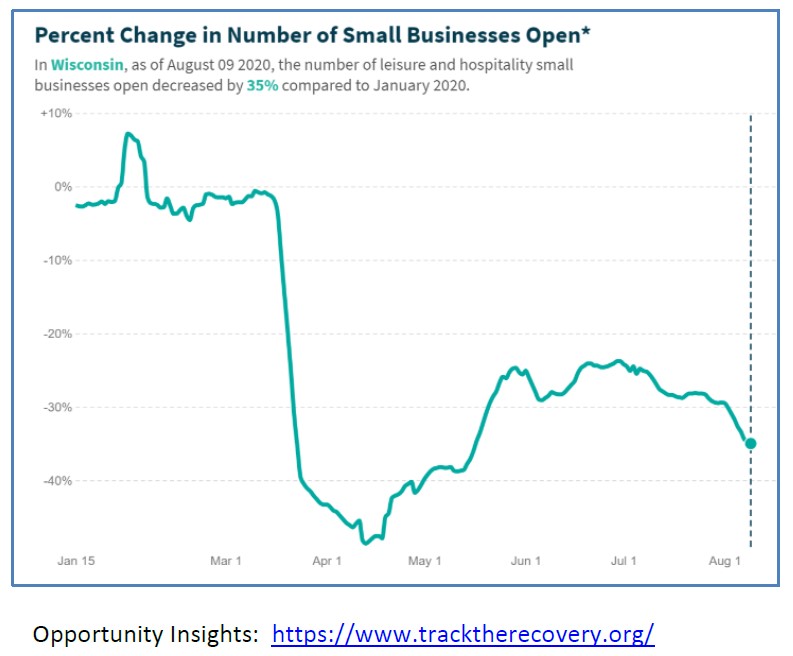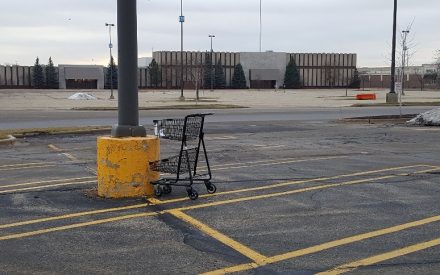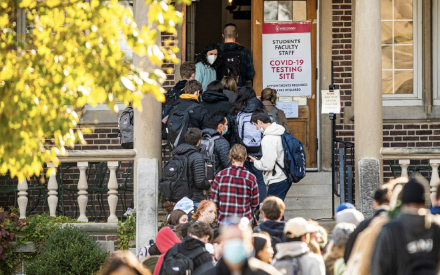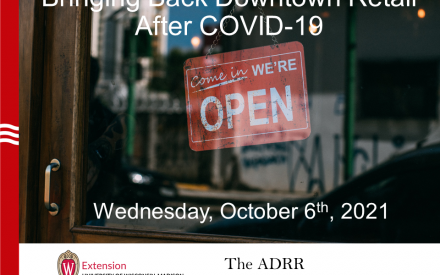September 2020 — Restaurants have become a key element in the business mix of downtowns throughout Wisconsin and the country. Their growth has helped reestablish downtown as the central social district of our communities. They have been a major employer and a visible example of entrepreneurship at work.
With the emergence of the COVID-19 pandemic, most food and beverage businesses had no choice but to close, either temporarily or permanently, or reconfigure their sources of revenue and operations to survive for an unknown period. Certain concepts have been able to stay open, and some that have even experienced an increase in sales, but most are debating if and when they can resume business as usual. Industry analysts estimate that between 25- to 50-percent of all restaurants are closed for good.
 Combining restaurants and hotels, the hospitality industry has 35-percent fewer businesses now than in January 2020 (see chart). The longer this continues, the more likely these closures will be permanent.
Combining restaurants and hotels, the hospitality industry has 35-percent fewer businesses now than in January 2020 (see chart). The longer this continues, the more likely these closures will be permanent.
The following are examples of how food and beverage establishments have changed their sources of revenue to maintain partial operations while ensuring the safety of their employees, customers, and the broader community. These examples of “pivoting” to new revenue sources may or may not apply to a given community given differences in local regulations and local conditions.
Provide off-premise dining options:
- Offer takeout from a menu that travels well. Sell alcoholic beverages and desserts. However, these sales alone can’t keep a business alive.
- Offer pre-packaged meals, including value and family packages.
- Offer curbside pickup and/or drive-thru lane so patrons can avoid having to go inside.
- Offer delivery orchestrated either locally or through a national service.
Create new and safe dining spaces:
- Convert parking spaces to dining patios
- Reroute traffic and close off a downtown block to vehicles and set up picnic tables instead
- Create enclosed outdoor dining booths separated by curtain walls or distance
Sell retail products: 
- Serve as a neighborhood general store by selling essentials like milk, eggs, chicken, deli items, but also specialty items such as bread and olive oil, spices, and sauces.
- Offer meal and cocktail kits that are versions of popular dishes and drinks that customers can prepare at home in a “take and bake” fashion.
- Sell existing inventory. The US Food and Drug
Administration issued interim guidance to allow
restaurants to sell food inventory more quickly.
Other sources of income:
- Restaurant chefs can teach online cooking classes for a fee.
- Partner with other businesses by selling each other’s products such as coffee, beer, spaghetti sauce, salad dressings, etc.
- Sell gift cards to generate immediate cash flow while building customer loyalty. Purchasers often spend more than the value of the card upon use.
- Alcoholic drinks to-go has been one of the most popular menu trends during the pandemic as many states lift restrictions on alcohol delivery.
- Running entirely online with high-profit items that are simple to fulfill.
- Lease less expensive production space in a ghost kitchen closer to your customers.
These alternative revenue ideas assume that restaurants continue to communicate with, care for, and mitigate risks to employee’s health and safey; that they maintain communication with their customer; and that they continue to serve their communities. Service could include donating to the local food pantry or preparing meals for healthcare workers.
Conclusion:
Determining ways to increase or bring in new sources of revenue is, in large part, a financial question. It involves estimating new sales, the cost of those sales, and the cost of labor to produce those sales. Not all sales contribute equally to the bottomline. While the ideas presented here will not replace sales from indoor seating, they might help generate ideas to at least supplement income.
The University of Wisconsin-Madison, Division of Extension, has developed Excel workbooks designed in the format of the Uniform System of Accounts for Restaurants that can create a 12-month budget or longer-term projection. In addition to experimenting with the revenue-generating ideas presented earlier, these Excel tools allow for conducting “what if” analyses if considering changes to fixed and variable costs, sales per customer, and changes to an operation’s customer volume. Contact william.ryan@wisc.edu for more information.
Sources: 7SHIFTS blog, Impossible Foods blog, The SpoonFood Technology blog, Restaurants Rise digital summit by Nation’s Restaurant News and Restaurant Hospitality.
*Written by William Ryan, community business development specialist with the University of Wisconsin Madison, Division of Extension; working with Jason Schleip, Wisconsin Small Business Development Center consultant specializing in the restaurant industry.














 COVID-19 and the Economy: U.S. Resident Experiences in the Late Stage of the COVID-19 Pandemic
COVID-19 and the Economy: U.S. Resident Experiences in the Late Stage of the COVID-19 Pandemic The Hotel Industry: Recovery and Future Development in Our Communities
The Hotel Industry: Recovery and Future Development in Our Communities The Rise Of Entrepreneurship During the Pandemic
The Rise Of Entrepreneurship During the Pandemic Bringing Back Downtown Retail After COVID-19
Bringing Back Downtown Retail After COVID-19


